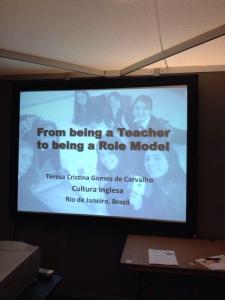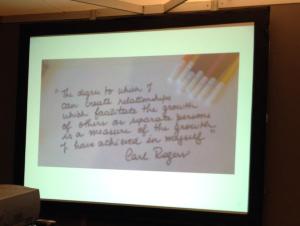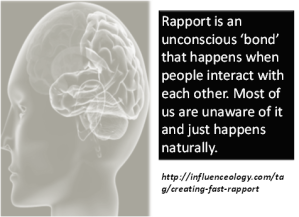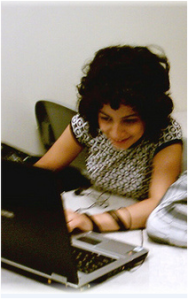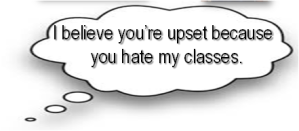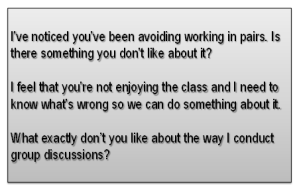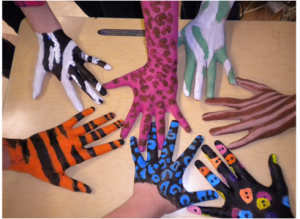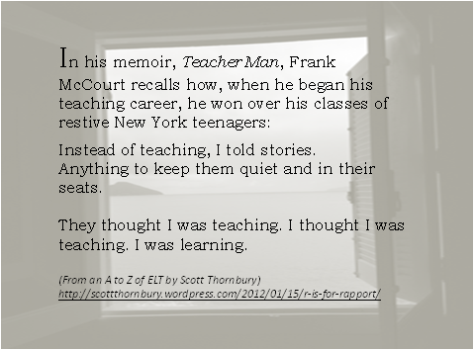The advantage of writing blog posts is that you can actually measure the impact it has on readers in real time. Technology has done wonders for us —first-timers and experienced writers now experience a more dynamic relationship with readers. As a teacher, I find it wonderful to discuss ideas — old and new alike, with fellow teachers from all around the world. It’s even better when we disagree because there’s more room for deeper thinking . Some people might say that disagreements get in the way of their writing, but I beg to differ. I believe that thanks to different opinions, we manage to strike a balance in this world full of contradictions and square pegs in round holes, or maybe round pegs in square holes. I believe we’re constantly swapping roles: My ideas may fit today but they may become outdated in a matter of days or they might merge with other ideas and become one. Who knows?
When it comes to teaching, accepting others’ opinions comes with the job if we believe in humanistic approaches, so this is my reply to Russ Mayne’s comment on my latest Richmond blog post entitled: Learning to Learn. In this post I discuss why I believe in Learning Styles. Unfortunately, due to the word limit, I cannot post my reply there, so, here is the link to my original blog post and to Russ Mayne’s comment:
http://www.richmondshare.com.br/learning-to-learn/
And here’s my reply to Russ:
Hi Russ, Thank you for your comment. It’s a privilege to receive feedback from someone as knowledgeable as you are. It is true that due to the word limit, I may have left out some important points, which I will humbly try to make up for in my reply to your comment.
You are absolutely right. There are some holes and gaps in my post, and perhaps I have failed to present convincing arguments for learning styles. So, please do let me make myself clear:
Firstly, I never said that authors advocate against learning styles. What I said was that ‘authors would agree that there is very little evidence that learning styles exist.’ Note that I have used ‘would agree’ so as to make it sound less assertive. By no means do I assume that they advocate against learning styles. However, they tend to assume that allowing learners to use their preferred learning styles is beneficial. As a matter of fact, many authors use the term ‘preferred styles.’
Lightbown & Spada (2009) say “there is a need for considerably more research. Nevertheless, when learners express a preference for seeing something written or spending more time in a language laboratory, we should not assume that their ways of working are wrong, even if they seem to be in conflict with the pedagogical approach we have adopted.”
After pointing out that there is little consensus among researchers, Jeremy Harmer (2007) says “it may sound as if, therefore, there is no point in reading about different learner styles at all — or trying to incorporate them into our teaching. But that is not the case. We should do as much as we can to understand the individual differences within a group. We should find descriptions that chime with our own perceptions, and we should endeavor to teach individuals as well as groups.’
Yes, I agree with Harmer. There are far too many different learner descriptions available out there, but we can and should try to find patterns to better adjust our teaching to the students and groups we have.
To support my claims even further, I would like to add Dr. Temple Grandin’s three types of thinkers in Autism, in which she divides learners up into three major learning styles: visual, music/math, and verbal learners. ” Since brains on the autistic spectrum are specialized, there needs to be more educational emphasis on building up their strengths instead of just working on their deficits. Tutoring me in algebra was useless because there was nothing for me to visualize. If I have no picture, I have no thought. Unfortunately I never had an opportunity to try trigonometry or geometry. Teachers and parents need to develop the child’s talents into skills that can eventually turn into satisfying jobs or hobbies.” (Grandin, Temple, Thinking in Pictures, 1996)
In her blog post for Wandering Educators, Roseli Serra (2014) claims that ‘working with learning styles makes us rethink our teaching practice, and gives us fundamental elements to build up a more appropriate methodology to lead our students to more effective learning of EFL. She continues and moves on to Brown (1994), who says that styles characterise the consistent and rather enduring traits, tendencies, or preferences that may differentiate one person from another. I would define learning style as individual preferences learners take so that learn better, that is, “an individual’s natural, habitual and preferred ways of absorbing, processing, and retaining new information and skills.” Learning styles will affect a person’s general approach to learning.
Towards the end of my post, I suggest that teachers let students decide whether they want to take notes or work in groups precisely because we must respect students’ individual needs. Anyone who has been teaching for as long as I have, will have probably noticed that some learners need to write things down while others do not; some students need to get up and move around while doing an activity while others would rather sit still. As I was writing my post, I originally considered including my own daughter’s example of a specific learning style and how her learning style still strikes me since it is so different from my own.
“As a teacher, I have always used lots of visuals, mind maps, sketches, and diagrams to explain language. When I helped my daughter prepare for her 8th grade final Portuguese exams, none of my explanations worked. I’d laid out a cardboard sheet on the table on which I’d drawn color lines and maps of the verb conjugations, adverbials, clauses, and other categories. “Just say it,” “I don’t need to see it,” she said impatiently.
Secondly, you are absolutely right when you say that authors believe in learning styles despite the lack of evidence. What I mean by ‘obvious’ is that it is present in many course books and yet teachers overlook it.
My blog post addresses both experienced and inexperienced teachers. It is also a fact that many of us — experienced or not, do not always read teachers’ manuals. I have lost count of how many times I have been given a class and a book to teach and not having access to the teachers’ manual. I have probably missed out on relevant information about authors’ beliefs and approaches to ELT. I bet many teachers out there do not have a chance to study the materials beforehand. When I started teaching in the mid-eighties, I taught audio-lingual and I had no idea of the beliefs and assumptions behind it; I just did what I had been told in the one-day training session. That said, it is fair to assume that many teachers apply learning styles in their classes without even being aware of it; and yet, some claim they do not believe in learning styles.
Thirdly, by no ‘right’ or no ‘wrong‘, I mean applying activities based on learning styles simply because it is exactly what my post is about: Learning Styles, and not about any other theory. I believe I have mentioned that Harmer has no objection to adopting learning styles as long as our classes are not ‘based solely on any of the learning style instruments.’ (2009).
In your enlightening IATEFL Harrogate talk, you quote Thornbury, who says that the learning styles theory is ‘ a convenient untruth.’ You go on on to say that it is convenient and useful for the students, but it is untrue. Well, I can only assume that learning styles are by no means harmful. The word choice speaks for itself: useful.
As for the prohibitions, you mention sounding like native speakers, which used to be the ultimate goal for students and teachers back in the 80s when I started teaching in Rio de Janeiro, Brazil. It was a time when teachers and learners strived to achieve native-like fluency. So, it is proof that the so-called truths and fads come and go. I would not be surprised if any of what we both claim to be absurd today made a comeback sometime in the near future.
Finally, you claim that learning styles do not exist. However, I claim they do. They are not a fad. They have been around in my classes all these years. In my teaching experience, I have observed students deal with an activity in different ways and I have helped these students learn in ways that work for them. Can researchers actually prove they do not exist at all? What is the foundation for the non existence of Learning Styles?
There may be little or no evidence of their existence, but I have the right to claim they exist even if it is just sheer intuition. I am myself a kinesthetic/visual learner. I need to see things and this — together with my beliefs, has an impact on the way I teach. Anyone who observes my classes will clearly notice that my students move around more than in other teachers’ classes and see things I draw on the board. However, because I believe in learning styles, I do not let my own teaching style dominate my classes. I also craft activities for auditory students, for example.
As a mentor, I have observed a large number of classes and I have had the privilege to sit back and observe teachers and students in action. I have concluded that the way one learns is definitely reflected in their teaching. I once observed an excellent class in which the teacher used no visual cues except for the ones in the material. He spoke and used body language to explain a grammar point. ‘How can he explain grammar this way?,’ I asked myself. To me, that would be just impossible.
Furthermore, I would like to remind you and my readers that my post is about learning styles only and why I believe they exist. By no means do I wish to extend it to other aspects of life or society when I affirm that ‘they are standing right before your eyes.’ I would like to clarify that the pronoun ‘the‘ is anaphoric and therefore it refers back to ‘learning styles’ in ‘yes, learning styles exist…’ so it is wrong to assume that they refer to any aspects other than learning styles.
I have been teaching long enough to form my own opinions and I am entitled to agree with whomever reflects my views; I might go a bit further and say that I feel free to change my mind whenever new possibilities and ideas emerge. So far, the evidence I have seen in my classes along all these years tell me that individuals have different learning styles which influence their behavior as students.
As Marjorie Rosenberg says in her webinar, it is not about labeling people; it is about offering learners activities and strategies they feel comfortable with.
I am a language learner and I have always been. I speak English as a foreign language and I have worked my way into the grammar system differently from my classmates. I am now learning French and my belief in Learning Styles allows me to adopt strategies that are consistent with my preferences.
We are not solely cognitive beings; we are much more complex than that. We cannot assume that people experience learning in the same way; many factors come into play: external and internal motivation, previous experiences, expectations, personality traits, and in my opinion, learning styles. I do not know what approaches or methods you use in your classes, but if you do not believe in learning styles, then how do you deal with your students’ preferred learning styles in practical terms?
Further Reading:
Grandin, T. Thinking in Pictures: My Life with Autism. Vintage Books 2006
Harmer, Jeremy. The Practice of English Language Teaching. Pearson Longman: 2008
Lightbown, P. M. & Spada, N. How Languages are Learned. Oxford: 2006
Mayne, R. A Guide to Pseudo-Science in English Language Teaching. (recorded IATEFL Harrogate Session)
Richards & Rodgers, Approaches and Methods in Language Teaching. CUP: 2008
Rosenberg, M. (January 11, 2015) Teaching to Learners of All Styles. IATEFL YLTSIG (recorded webinar)
http://iateflyltsig.wiziq.com/online-class/2144602-ylt-webinars-teaching-to-learners-of-all-styles
Serra, R.. (November 14, 2014) Do we Care about Learning Styles? Wandering Educators (online):
http://www.wanderingeducators.com/language/learning/do-we-care-about-learning-styles.html
Grandin, T. Thinking in Pictures: My Life with Autism. Vintage Books 2006


